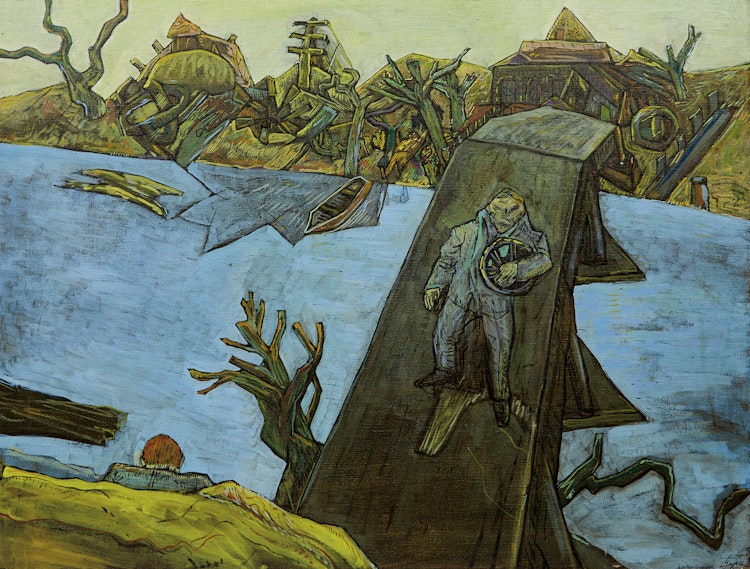Man on the Bridge by Ivan Kenneth Eyre

Ivan Eyre
Man on the Bridge
oil on canvas
signed lower right; titled and dated 1963 on a gallery label on the reverse
26 x 34 ins ( 66 x 86.4 cms )
Auction Estimate: $15,000.00 - $20,000.00
Price Realized $14,400.00
Sale date: June 8th 2023
Lillian Adamson, Winnipeg
Private Collection, Winnipeg
“Ivan Eyre: Personal Mythologies”, National Gallery of Canada, Ottawa, travelling to Winnipeg Art Gallery; Nickle Arts Museum, Calgary; The Edmonton Art Gallery; London Regional Art Gallery, 28 September 1988‒21 January 1990, no. 5
Terrence Heath, “Ivan Eyre: Personal Mythologies”, Winnipeg, 1988, no. 5, reproduced page 33
Donalda Johnson, “Eyre With Honour”, Winnipeg, 1994, page 8
“Ivan Eyre: The Paintings”, Assiniboine Park, 2004, pages 18-19
Denis Cooley, Amy Karlinsky and Mary Reid, “Figure Ground: The Paintings and Drawings of Ivan Eyre”, Winnipeg, 2005, pages 17-18
Ivan Eyre was heavily influenced by the Canadian prairie landscape, commenting on the landscape genre of painting: “The subject is inexhaustible. Infinite possibilities exist. It’s still possible to make of a landscape a very personal statement even a radical one, different from anything previous.”
Share this item with your friends
Ivan Kenneth Eyre
(1935 - 2022) RCA
Ivan Kenneth Eyre was born in Tullymet, Saskatchewan in 1935. At the Saskatoon Technical Collegiate he studied under Ernest Lindner, followed by studies at the University of Saskatchewan under Eli Bornstein in 1952. At the University of Manitoba School of Art, he studied under several notable teachers graduating in 1957 with a Bachelor of Fine Arts. In 1958-59 he attended the University of North Dakota in Grand Forks where he also taught. Upon returning to Canada, he took a teaching job at the University of Manitoba where he was appointed Full Professor (of painting and drawing) and where he stayed until his retirement in 1993. In 1966-67, he travelled in England and Europe where he was able to sell many of his paintings to private collectors. His works were inspired by the Symbolist philosophy of following subjective recollection and reaction rather than the Realist-Impressionist technique of objective observation-based painting. He is very much part of the artistic scene of the Prairies where he has lived most of his life. Eyre is also known for his graphite, crayon studies, and woodcuts. Among his many honours, he was elected member of the Royal Canadian Academy in 1974, received the Queen's Silver Jubilee medal in 1977, the University of Manitoba Alumni Jubilee Award in 1982, and was the subject of several films and books. He has held solo exhibitions from 1962 to the present and participated in many group shows. His works hang in numerous private and public collections in Canada and abroad. Winnipeg is the home to the Pavilion Gallery which houses the largest permanent of Eyre's paintings representing 170 works on canvas and over 5000 drawings. Ivan Eyre lived and worked in Winnipeg, Manitoba.

